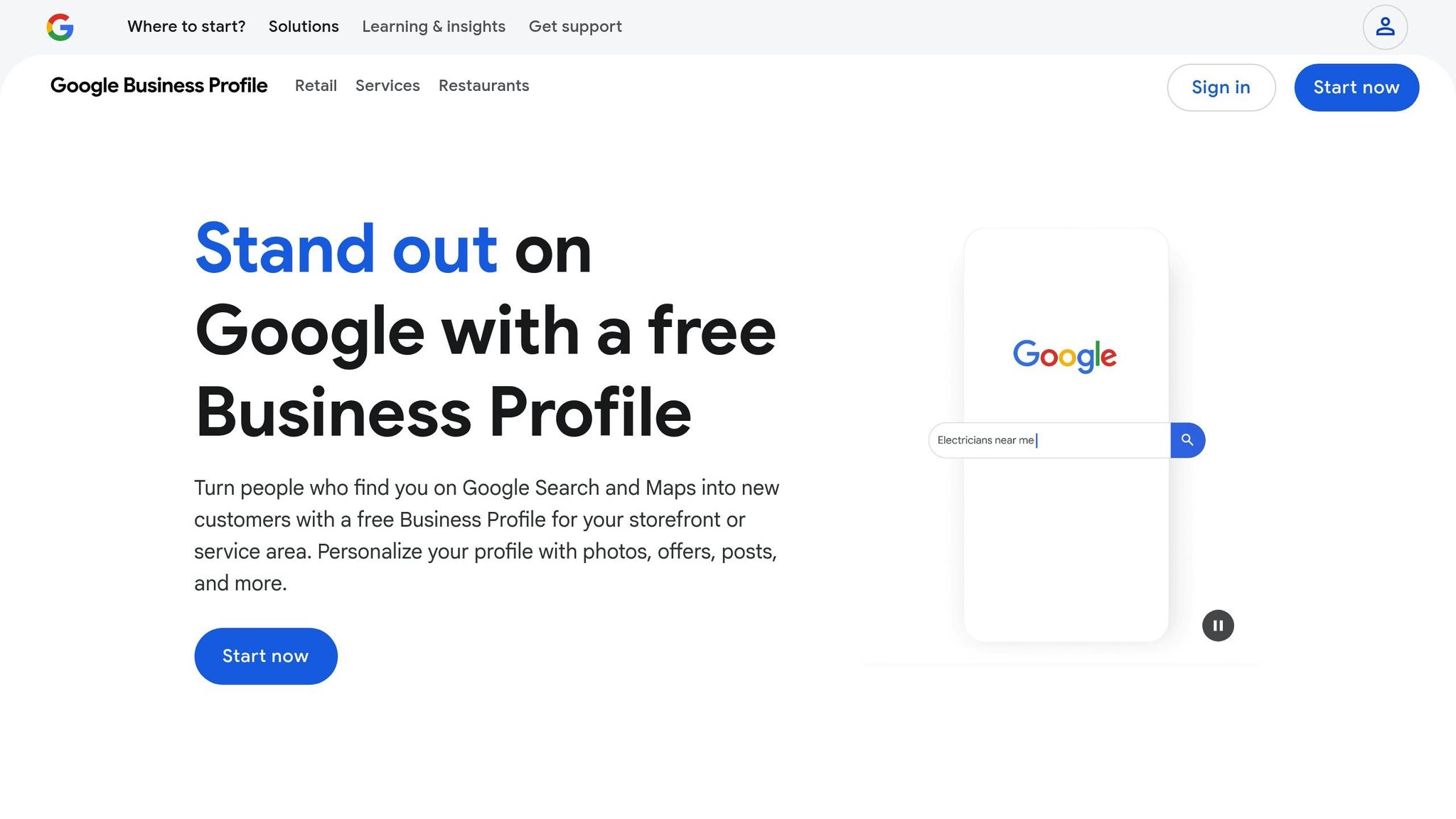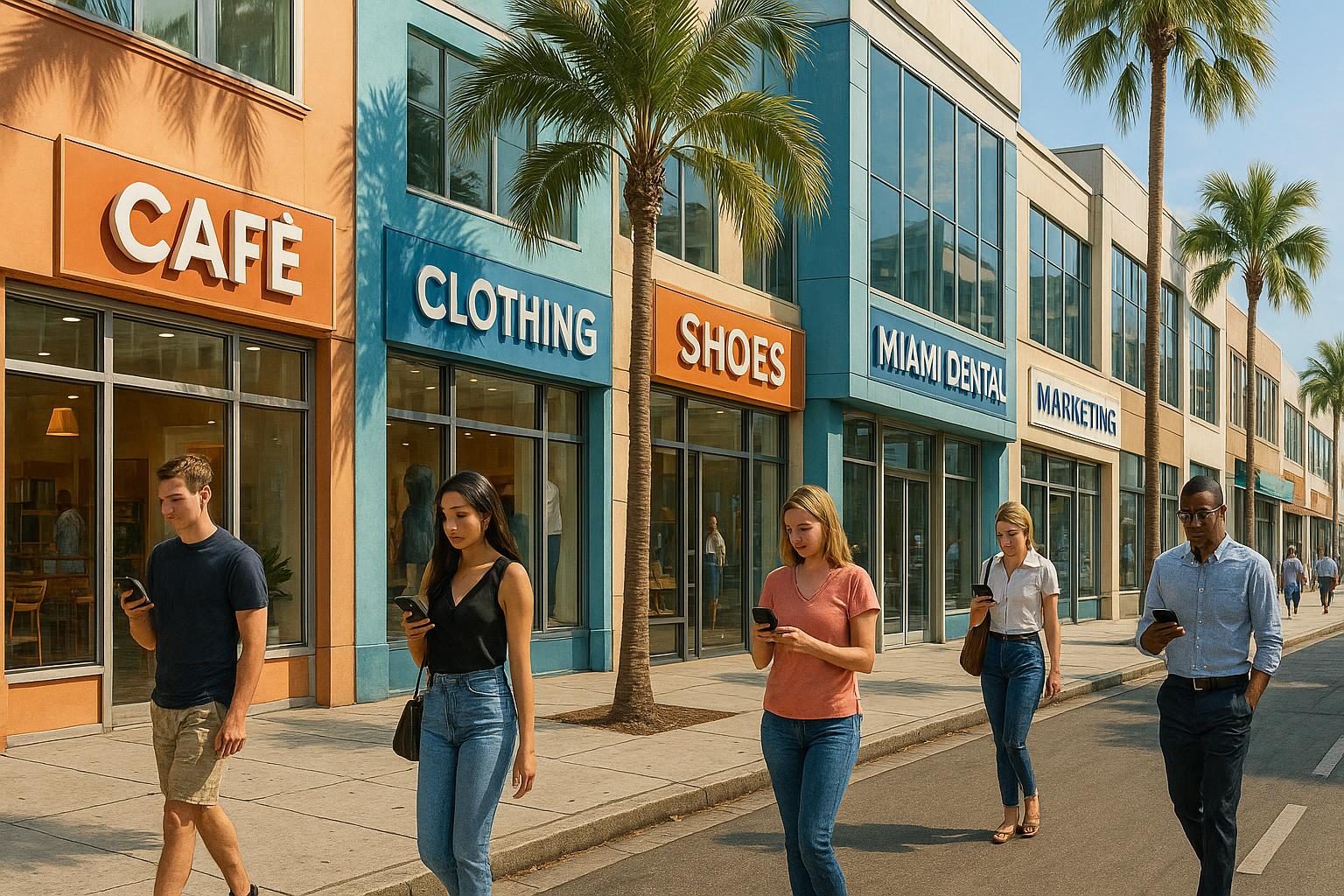Local businesses in Miami face five major SEO challenges in 2025:
- Crowded Local Market: Intense competition from local, national, and global businesses makes it tough to rank for popular keywords.
- Solution: Use hyper-local and long-tail keywords like "Wynwood brunch spot" or "emergency plumber Aventura Sunday."
- Google Business Profile Updates & Reviews: Keeping profiles accurate and managing multilingual reviews is critical.
- Solution: Regularly update hours, locations, and photos while responding promptly to reviews in the customer’s language.
- Mobile-First Indexing: With heavy reliance on smartphones, a fast, user-friendly mobile site is non-negotiable.
- Solution: Conduct mobile SEO audits, improve site speed, and simplify navigation.
- Local Business Schema: Structured data improves visibility in search results.
- Solution: Add schema markup with consistent business details like name, address, and hours.
- Tracking SERP Performance: Algorithm changes and local competition demand ongoing performance monitoring.
- Solution: Use automated tools to track rankings, SERP features, and competitor movements.
Challenge 1: Competing in a Crowded Local Market
Miami’s rapid growth has transformed it into a fiercely competitive business hub. The hospitality industry, for instance, is booming with a steady stream of new hotels, restaurants, and entertainment venues. Real estate agencies are thriving as property values soar, and e-commerce businesses are flocking to Miami, drawn by its strategic position as a gateway to Latin America.
But this growth comes with a challenge: market saturation. Local search rankings are feeling the squeeze as businesses vie for visibility. Keywords like “Miami restaurant” are flooded with competition, not only from local businesses but also from national chains and global brands with deep pockets and advanced SEO strategies. For smaller businesses, this crowded field can push them off the first page of search results, increasing their reliance on costly paid ads. Add in Miami’s seasonal tourism and its international appeal, and businesses find themselves competing for both residents and visitors.
To stand out in this packed market, businesses need to rethink their approach to keywords.
Finding Location-Specific Keywords
The secret to navigating Miami’s crowded market lies in targeting hyper-local keywords. Instead of competing for broad terms, focus on phrases like “Wynwood brunch spot” or “Coral Gables family dentist.” These niche terms help businesses connect with specific audiences searching for services in particular neighborhoods.
Start by identifying Miami’s unique neighborhoods and their distinct characteristics. South Beach, for example, draws tourists and nightlife enthusiasts, while Coconut Grove appeals to families and professionals. A fitness studio in Brickell might target “downtown Miami gym,” while another in Little Havana could use “Calle Ocho fitness classes.” By tailoring keywords to these local nuances, businesses can better match user intent.
Long-tail keywords – those three- to five-word phrases – are especially valuable in saturated markets. While these terms may have lower search volumes, they signal highly specific needs. A phrase like “emergency plumber Aventura Sunday” is far more likely to convert than a generic search term.
Advanced keyword research tools can uncover untapped opportunities, including bilingual keyword strategies. Miami’s large Spanish-speaking population offers a chance to stand out with terms like “restaurante Kendall” or “abogado accidentes Miami.” Pairing these strategies with localized content helps businesses establish a stronger presence in search results.
Creating Content for Local Communities
To rise above the noise, businesses must craft content that resonates with Miami’s diverse communities.
Event-driven content is particularly effective in Miami, where festivals and cultural happenings dominate the calendar. A catering company, for instance, could create content around high-profile events like Art Basel, Ultra Music Festival, or Miami Fashion Week. This positions the business as a trusted partner during these peak times while boosting local visibility.
Neighborhood-focused guides also perform well. A real estate agent might publish detailed overviews of Miami neighborhoods, covering everything from school districts to the best local eateries. This type of content appeals to both current residents exploring new areas and newcomers researching where to settle.
Stories about community involvement can help businesses stand out. Sharing experiences like sponsoring youth sports teams, participating in charity events, or collaborating with other Miami-based businesses builds trust and strengthens local connections.
Content tailored to Miami’s climate can also engage local audiences. For example, a landscaping company might share tips on hurricane-resistant plants, while a clothing retailer could offer advice on year-round summer fashion. Such content not only addresses practical needs but also reinforces a business’s relevance to the local environment.
Finally, celebrating Miami’s cultural diversity is a powerful way to connect with its international community. Highlighting multilingual services, addressing the needs of global investors, or sharing stories that reflect Miami’s multicultural identity can build trust and set a business apart in this vibrant city.
Challenge 2: Managing Google Business Profile Updates and Reviews

For businesses in Miami, staying on top of Google Business Profile updates is crucial for improving local SEO. However, it’s no small task. The city’s vibrant and ever-changing business landscape – shaped by seasonal trends and a multilingual customer base – makes maintaining accurate and engaging profiles a bit more challenging.
Failing to keep your profile updated or ignoring customer feedback can hurt your visibility in search results. Both locals and tourists rely on accurate information and timely reviews to decide where to spend their money. Below are practical steps to help you keep your profile up-to-date and handle reviews effectively.
Keeping Your Profile Updated and Accurate
Make it a habit to update your business hours, location, services, and photos regularly. This is especially important in Miami, where seasonal events and tourist influxes can lead to frequent changes. For example, a restaurant in a busy tourist area might extend its hours during festivals, while retail stores may adjust schedules based on peak travel seasons.
For service-based businesses, double-check that your location and service areas are clearly defined. If your business operates in one neighborhood but serves surrounding areas, specifying these regions ensures your profile shows up in relevant local searches.
Fresh, high-quality photos are another must. Regularly updating images gives potential customers a better sense of your business’s current vibe and offerings, which can help you stand out.
Don’t forget to cater to Miami’s diverse audience by including multilingual contact details. This ensures you’re accessible to a broader range of customers. Regularly reviewing your profile helps catch any outdated information and keeps everything aligned with your current operations.
Once your profile is in good shape, it’s time to focus on managing customer reviews effectively.
Managing Customer Reviews and Feedback
When it comes to reviews, a one-size-fits-all approach doesn’t work. Miami’s mix of local and international customers means businesses need tailored strategies for different audiences.
Responding promptly to reviews – whether they’re glowing or critical – is key. Quick responses show customers that their feedback matters and help build trust. For Miami’s multilingual community, replying in the same language as the review can go a long way in making customers feel valued and understood.
Negative reviews require special attention. Start by acknowledging the customer’s concerns, then offer a clear solution and provide a direct way for them to follow up. This approach can help minimize any potential damage to your reputation.
To encourage more reviews, adapt your strategies to different customer groups. For example, follow up with tourists via email after their visit, while using text message requests for local patrons. This personalized approach can boost the number of reviews you receive.
Finally, keep an eye on review trends and be on the lookout for fake or suspicious reviews. Genuine feedback is a goldmine for improving your services and building a trustworthy online presence. By staying proactive, you can ensure your Google Business Profile remains an asset to your business.
Challenge 3: Mobile-First Indexing and User Experience
In Miami, where life moves at lightning speed, most people rely on their phones to find what they need – whether it’s tourists hunting for the best Cuban sandwich in Little Havana or locals booking a last-minute hair appointment in Coral Gables. With mobile-first indexing now standard, having a fast and smooth mobile website isn’t just a bonus – it’s a must for both search rankings and customer conversions.
The stakes are high. Mobile users in Miami expect instant results. A slow-loading site or clunky mobile experience? That’s all it takes for potential customers to move on to a competitor. And because Miami’s population is so diverse, your mobile site has to work reliably across a range of devices and internet speeds. Whether it’s someone with the latest smartphone in Brickell or an older device in another neighborhood, your site needs to deliver consistently.
Conducting Mobile SEO Audits
Start with Google’s Mobile-Friendly Test to evaluate your site’s Core Web Vitals. Focus on these key metrics:
- LCP (Largest Contentful Paint): Keep it under 2.5 seconds.
- FID (First Input Delay): Aim for less than 100 milliseconds.
- CLS (Cumulative Layout Shift): Keep it below 0.1 to avoid jarring shifts on the page.
Don’t stop there. Test your site’s speed on different connection types, from high-speed fiber to slower networks. Miami’s mix of fast and slow connections means your site needs to perform well across the board. Images often cause delays – compress them carefully and use modern formats like WebP to maintain quality without slowing things down.
Your site’s usability is just as important. Make sure menus are easy to find, and ensure critical pages are no more than two taps away. These steps set the foundation for a better mobile experience.
If you’re dealing with complex issues, technical SEO services can help pinpoint and resolve mobile performance problems tailored to Miami’s unique needs.
Improving Mobile User Experience
Once you’ve identified problem areas, focus on refining the mobile experience to meet the expectations of Miami’s fast-moving users.
Simplify navigation by making key information – like your location, hours, and contact details – easy to find. Add a prominent "Get Directions" button that links directly to mapping apps. This is especially helpful for tourists and locals trying to navigate Miami’s intricate streets.
Keep your NAP (Name, Address, Phone) details consistent across your site and your Google Business Profile. Even minor inconsistencies can hurt your local search rankings. Also, ensure your phone number is clickable for a seamless customer experience.
To capture local search intent, create mobile-friendly landing pages tailored to specific neighborhoods. For example, a plumbing business could have separate pages for "Emergency Plumber in Wynwood" and "Plumber in Coconut Grove", each with localized content and directions.
If you’re in e-commerce, streamline your mobile checkout process. Miami shoppers, especially tourists, often make quick purchasing decisions. Reduce the number of form fields, allow guest checkouts, and integrate payment options like Apple Pay and Google Pay to make transactions effortless.
Given Miami’s multilingual audience, make sure language switchers are easy to find on mobile. Translated content should display properly on smaller screens without sacrificing usability.
Finally, test your site during Miami’s busiest times, like Art Basel or Ultra Music Festival, when thousands of users are online at once. A content delivery network (CDN) can help maintain fast loading times even during peak traffic periods.
For businesses targeting mobile users, mobile keyword research can uncover the most popular search terms Miami customers use on their phones, helping you optimize your content for maximum reach.
Challenge 4: Using Local Business Schema and Structured Data
In Miami’s buzzing digital marketplace, getting noticed means speaking Google’s language fluently. Local business schema markup is a form of structured data that gives search engines a clear picture of your business – what it offers, where it’s located, and how to reach you. For Miami businesses navigating fierce competition, schema markup can be the key to standing out. It’s what gets you into those eye-catching rich snippets with star ratings, business hours, and contact details instead of fading into the standard search results.
Using schema effectively can boost click-through rates by up to 30%. And in Miami’s diverse, multilingual environment, it’s even more crucial. With over 60% of local searches leading to a visit within 24 hours, having accurate, structured data ensures that both locals and visitors can find you quickly and easily.
Setting Up Local Business Schema
Structured data takes your online presence to the next level, complementing strategies like managing profiles and optimizing for mobile.
Start by collecting all your business details in one place. This includes your exact business name, full address, phone number, business hours, geo-coordinates, and service area. Consistency is key – any mismatch between your schema data and your Google Business Profile can hurt your rankings.
To create the schema, use tools like Google’s Structured Data Markup Helper or visit schema.org to generate JSON-LD code. JSON-LD is Google’s preferred format because it’s clean and doesn’t interfere with your website’s design. Include essential details like your business name, address, phone number, opening hours, geo-coordinates, service area, and website URL.
For example, if you’re a Miami restaurant, you might highlight specifics like "serves Cuban cuisine", "accepts reservations", or "offers outdoor seating." These details help search engines understand what you provide and when to showcase your business in search results.
Add this markup to your homepage and any location-specific pages. If you operate multiple locations in Miami – say, one in Brickell and another in Coconut Grove – create unique schema entries for each, complete with specific NAP (Name, Address, Phone) data and geo-coordinates.
Once implemented, validate your schema using Google’s Rich Results Test, and monitor it through Google Search Console. These tools help you catch errors early and ensure that Google interprets your structured data as intended.
For businesses that want a smoother process, SearchX’s technical SEO services can handle schema implementation tailored to Miami’s competitive landscape.
Fixing Common Schema Markup Errors
After you’ve added schema markup, it’s important to review it for common mistakes that could hurt its effectiveness.
One frequent issue is inconsistent NAP data. Miami businesses often use slightly different names, addresses, or phone numbers across their schema, website, and Google Business Profile. Search engines expect consistency in key details like business hours, geo-coordinates, and contact info.
Another common problem is property name errors. Schema.org has specific naming conventions, and using the wrong ones – like phoneNumber instead of phone or streetAddress instead of address – can cause your markup to fail. It’s essential to follow these standards closely.
Many businesses in Miami also forget to update their schema after making operational changes. Outdated information in your structured data can confuse search engines and frustrate potential customers.
To prevent these issues, regularly audit your schema using Google’s Rich Results Test. Confirm that all required fields are accurate, ensure that your NAP data matches across platforms, and verify that you’re using the right schema type for your business.
Given Miami’s multilingual audience, it’s worth considering bilingual schema descriptions in English and Spanish where relevant. Although schema.org doesn’t officially support multilingual data, including bilingual details in your business descriptions and services can help you reach a broader audience.
Lastly, schedule regular reviews to keep your schema up to date. Whether it’s a change in business hours, services, or contact information, staying current ensures your structured data continues to work for you. With effective schema markup, you’ll strengthen your local SEO strategy and stay visible in Miami’s competitive landscape.
sbb-itb-880d5b6
Challenge 5: Tracking SERP Performance and Algorithm Changes
In Miami’s ever-changing local search environment, staying visible online isn’t just about setting up your SEO strategy and hoping for the best. Success hinges on tracking your SERP (Search Engine Results Page) performance, which ties directly to mobile optimization and schema strategies mentioned earlier. With Google frequently adjusting its algorithms, Miami businesses face the ongoing challenge of keeping an eye on their rankings while adapting to updates that can shake up local visibility overnight.
For example, your business might rank well for "Miami restaurant" but struggle with "restaurante Miami." Without consistent tracking, these shifts could go unnoticed. This can lead to losing customers to competitors or wasting resources on ineffective marketing strategies.
SERP tracking isn’t just about checking a handful of keywords. It involves monitoring your visibility across devices, different Miami neighborhoods, and search features like Google Business Profiles, local packs, and featured snippets. This broader approach helps you understand not only where you rank but also how algorithm updates influence your local search presence. Up next, let’s dive into how automated tools can make this process easier for Miami’s fast-paced market.
Using SERP Tracking Tools
Automated SERP tracking tools simplify the process by turning complex data into actionable insights. These tools monitor rankings for hundreds of keywords, track competitors, and send alerts about significant changes – giving you the chance to respond before it affects your business.
For Miami businesses, these tools offer specific advantages. They can track rankings across various Miami-Dade County areas, compare mobile and desktop performance, and identify when your business shows up in local pack results versus organic listings. This level of detail reveals how search results differ for customers in Coral Gables compared to those in Downtown Miami.
Another key feature is location-specific tracking, which simulates searches from different ZIP codes across Miami. This is especially helpful when you’re looking to expand your reach from South Beach to areas like Aventura or Little Havana.
Modern tools also go beyond traditional rankings by monitoring enhanced SERP features. They can notify you when your Google Business Profile appears in local pack results, track your visibility in "People also ask" sections, and help identify opportunities to capture featured snippets. For competitive industries like real estate or hospitality, securing these features can make all the difference in standing out to potential customers.
By leveraging these insights, you can fine-tune your local SEO strategy, focus on impactful ranking improvements, and avoid wasting time on minor keyword fluctuations.
For businesses ready to streamline their efforts, tools like SearchX’s SERP feature tracking tools offer a tailored approach to Miami’s dynamic market.
Manual vs Automated SERP Tracking Methods
While automated tools bring efficiency and accuracy, it’s worth understanding how they compare to manual tracking. Here’s a breakdown:
| Aspect | Manual Tracking | Automated Tracking |
|---|---|---|
| Cost | Free but time-consuming | $50–$500+ per month, based on keywords tracked |
| Time Investment | 2–5 hours weekly for basic tracking | 15–30 minutes weekly for analysis |
| Accuracy | Prone to human error and search inconsistencies | Highly reliable with standardized parameters |
| Scalability | Hard to track beyond 20–30 keywords | Easily manages 1,000+ keywords |
| Geographic Precision | Limited to your physical location | Simulates searches from any Miami neighborhood |
| Historical Data | Requires manual recording | Automatically stores months or years of data |
| Competitor Monitoring | Extremely labor-intensive | Effortlessly tracks multiple competitors |
| Alert System | No automatic notifications | Sends instant alerts for ranking changes |
Manual tracking might work for very small businesses just starting out. You can check rankings by searching Google from different devices and locations, but this method quickly becomes unreliable. Search results vary based on factors like your location, device, and browsing history, making consistent manual tracking almost impossible. Plus, Google personalizes results based on your past searches, so what you see may not reflect what potential customers see.
Automated tools eliminate these inconsistencies by using clean IP addresses and standardized search settings. They provide accurate, dependable data to guide your SEO strategy and budget planning.
For Miami businesses managing multiple keywords or targeting diverse neighborhoods, automated tracking is a must. The time saved and improved precision often make the investment worthwhile from the start.
Whether you choose manual or automated tracking, keeping a close eye on your SERP performance is critical for staying visible in Miami’s competitive local market.
Conclusion: Staying Competitive in Miami’s Local SEO Market
Miami’s local SEO scene in 2025 comes with its own set of challenges, and succeeding here requires a well-thought-out strategy. The five key obstacles – competing in crowded markets, keeping up with Google Business Profile updates, optimizing for mobile-first indexing, utilizing local business schema, and tracking SERP performance – are all interconnected parts of a bigger picture. Tackling these effectively means addressing Miami’s competitive environment with precision and focus.
The secret to overcoming these hurdles lies in adopting a data-driven approach. Whether you’re fine-tuning location-specific keywords for areas like Coral Gables or Downtown Miami, ensuring your mobile page speed is up to par, or troubleshooting schema markup errors, every decision needs to be backed by accurate data. Miami’s fast-paced digital ecosystem leaves no room for guesswork or manual tracking.
At the heart of it all is mobile optimization and technical SEO. From speeding up your site to implementing structured data, these elements determine how Google ranks and displays your business – especially as more users rely on their phones while exploring neighborhoods like South Beach or Little Havana.
For businesses looking to stay ahead, addressing these challenges systematically is key. Tools like SearchX’s comprehensive SEO solutions can help maintain visibility across Miami’s diverse markets. By combining technical SEO expertise with strategic local SEO efforts, businesses can adapt to algorithm changes while staying consistently visible across Miami-Dade County.
FAQs
What are the best ways for Miami businesses to optimize their Google Business Profile for better local SEO results?
To make the most of your Google Business Profile and improve your local SEO, double-check that all your business information – like your address, phone number, and hours – is accurate and consistent across platforms. Sprinkle in relevant local keywords when crafting your business description and posts to better connect with Miami customers. Keep your profile fresh by regularly adding updates like announcements, photos, and special promotions.
Don’t overlook customer reviews – responding promptly and professionally to both positive and negative feedback can go a long way. Using neighborhood-specific keywords and showcasing seasonal offerings can also help you stand out in Miami’s competitive market. Staying active and detail-oriented with your profile can make a big difference in boosting your local search presence and drawing in more customers.
How can small businesses in Miami stand out and compete with larger brands in a crowded local market?
Small businesses in Miami can stand out by diving into hyper-local SEO strategies. This means crafting content that speaks directly to specific neighborhoods and optimizing for location-focused keywords. Think of it as speaking the language of your local community online. Beyond that, getting involved in the community through partnerships, hosting events, or sponsoring local initiatives can go a long way in building trust and boosting visibility.
Another key area is social media. Miami’s audience is vibrant and diverse, so sharing genuine, locally relevant content can help your brand connect on a deeper level. It’s not just about posting – it’s about building relationships and fostering loyalty.
Lastly, finding a unique niche or offering services tailored to individual needs can set your business apart from the bigger players. Personalization and a clear focus can attract loyal, local customers who appreciate the attention to detail and community connection.
Why is mobile-first indexing important for Miami businesses, and how can they optimize their mobile sites effectively?
Why Mobile-First Indexing Matters for Miami Businesses in 2025
In 2025, Google continues to prioritize mobile-first indexing, meaning it primarily evaluates the mobile version of a website when determining search rankings. For businesses in Miami, this is a big deal. With so many locals relying on their smartphones to discover places to eat, shop, or book services, having a mobile-friendly website isn’t just helpful – it’s necessary to stay visible and competitive.
If you want your mobile site to perform well, focus on speed, usability, and design. Make sure your pages load quickly, navigation is simple and intuitive, and the layout is designed with mobile users in mind (think large, easy-to-tap buttons and readable fonts). Optimized images and clear, concise content also go a long way in creating a smooth experience. Not only will this help your rankings, but it’ll also keep potential customers engaged and coming back.




